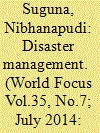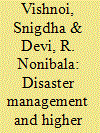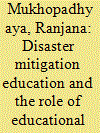|
|
|
Sort Order |
|
|
|
Items / Page
|
|
|
|
|
|
|
| Srl | Item |
| 1 |
ID:
132497


|
|
|
|
|
| Publication |
2014.
|
| Summary/Abstract |
Hundreds of Natural disasters take place worldwide every year causing irreparable damage to life and property. Earthquakes, ?oods, typhoons, hurricanes,- Tsunamis are among the worst of these natural disasters. Over the last few decades, there has been an alarming increase in the occurrence of natural disasters and the magnitude of their social, economic and environmental impact. During any natural disaster it is usually the" children who suffer the most. The nation witnessed the death of nearly a thousand children during the 2001 Bhuj earthquake. Out of them, 300 died while marching for the Republic day parade. They were in a narrow lane when the earthquake hit causing buildings onboth sides to collapse. It is said thatpnearly 1,884 school buildings collapsed leading to a loss of 5,950 class rooms. About 12000 schools suffered damages making them un?t for children to continue their studies. Fire tragedies, like the one in Kurnbakonam killed 93 children in a school. Another ?re accident in Dabwali, Haryana where a ?re broke out during a schoolfunction took he lives of many school children. Children in schools are the 'most vulnerable group during any disaster. These tragedies reiterate the need for all of us to sit up and think about the safety of these children. It is necessary to make schools safe and hazard proof. For this purpose, it is important to have disaster management, emergency preparedness and response plans at school level.
|
|
|
|
|
|
|
|
|
|
|
|
|
|
|
|
| 2 |
ID:
132496


|
|
|
|
|
| Publication |
2014.
|
| Summary/Abstract |
School and higher education has received a very important place in the l2 " Plan document submitted by the working group on disaster management'. There is a paradigm shift in the approach of this document as it has not only earmarked adequate funding for school and higher education, technical education and medical education, but has for the first time tried to use the human resources in a fruitful manner. While the 12"education lists major initiatives which needs to be taken, it has yet to specify the road map for successful. implementation of the recommendations outlining speci?c roles that various stakeholders may play. The Department of Anthropology, University of Delhi, organized a one day seminar to critically examine the document of 12* Five Year Plan with special reference to the 'role of higher education in disaster management.' Ahumble introduction of the chairperson Prof. Vinay Kumar Srivastava, former Principal, Hindu College, and other distinguished speakers, which included Prof. R. B. Singh, Vice President International - Geography Union; Dr. Ranjana Mukhpadhyay, Chairperson, Samutthan Eoundation; Dr Urfat Anjem Mir, Ambedkar University, New Delhi; Dr. Angeli Qwatra, Philanthrope, New Delhi; Dr. Sunita Reddy, Jawaharlal Nehru_University; Prof. V. R. Rao, former Director, Anthropological Survey of India was provided to the audience sharing the expertise and interests of each one of them. Prof. P.C Joshi, Asia Coordinator, EU Integrated Project MICRODIS and President, Society for Indian Medical Anthropology, initiatedthe discussion by sharing the concern of thinking of ways of mainstreaming disaster education at various levels and cadres. It was emphasized to discuss the role and capacities of universities in particular to impart awareness, and support action towards the -same.
|
|
|
|
|
|
|
|
|
|
|
|
|
|
|
|
| 3 |
ID:
132498


|
|
|
|
|
| Publication |
2014.
|
| Summary/Abstract |
Disasters are increasing exponentially. The number of disaster events which was 73 in 1900-09 has increased to 4494 during 2000-09. More people were affected in the two recent decades than the earlier ones. During the second half of the 20th century, more than 200 major natural disasters occurred in different parts of the world and claimed the lives of around 1.4 million people. In 2011 alone, 302 hazards resulted in disasters that claimed almost 30,000 lives, affected 206 million people and in?icted damages worth an estimated USS 366 billion, according to the United Nations Office for Disaster Risk Reduction.
|
|
|
|
|
|
|
|
|
|
|
|
|
|
|
|
|
|
|
|
|